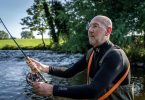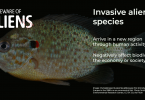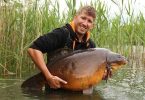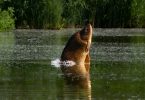Following the introduction by the authorities in Norway of stringent new limits for parasite numbers on their salmon farms, the S&TA, Britain’s leading gamefish conservation charity, is calling on the Scottish Government to apply the same rigorous criteria to salmon farming operations in the west Highlands and Islands.
Reacting to a severe increase in sea lice infestations on farms during the autumn of 2009, the Norwegian Ministry of Fisheries has decreed that this spring numbers of the sea lice in the country’s marine salmon farms must not exceed 0.1 lice per fish (one louse per ten salmon per pen). Part of the rationale for this move is a determination to minimise any “population-reducing effect” on juvenile wild salmonids as they migrate past the coastal salmon farms to the open sea. If the numbers of sea lice are not within the permitted limits, then an order for the mass slaughter of all the farmed salmon in the pen may be issued. The Scottish salmon farming industry’s target for sea lice in the spring is 0.5 lice per fish.
Paul Knight, Chief Executive of S&TA, commented: “Clearly the limit for sea lice set by the Norwegian authorities for this coming spring is an indication that they are taking the sea lice issue very seriously. This is in stark contrast to the situation in the west Highlands and Islands where the salmon farming industry will be allowed to operate with five times as many lice per salmon cage compared to what is permissible in Norway. The salmon farms in both Norway and Scotland are by and large under the same ownership – that of Norwegian conglomerates. This begs the obvious question – why should these Norwegian companies be allowed to operate in Scotland at much lower environmental standards than are required in their home country?”
Mr Knight added: “It is also inequitable that the sea lice limits laid down in Norway are enforceable by law whilst in Scotland the salmon farmers set their own limits under the industry’s Code of Good Practice, a nebulous and toothless document which has no legal status. It is surely time for the Scottish Government to introduce statutory limits for sea lice in salmon cages so that the Norwegian companies operating here are obliged to adhere to similar environmental standards and regulations as are in force across the North Sea. If we are to have any hope of restoring runs of wild salmon and sea trout in the west Highlands, then a prerequisite is proper regulation of the salmon farming industry including where necessary the sanction of slaughter of the stock in those farms that do not comply”.
Jon Gibb, Clerk to the Lochaber District Salmon Fishery Board with responsibility for wild fish runs in one of the most intensively farmed areas of the west coast, commented: “Leading west Highland fisheries managers have long recognised that the current salmon industry target of 0.5 lice per fish during the spring is far too high to prevent a devastating impact on migrating wild smolts. Our calls for this target to be drastically reduced have been ignored. Now that the Norwegian authorities are implementing a far tougher regime, surely it is time for the Scottish Government to follow suit. If it does not, then increasingly Scotland will be open to the charge that it is the dumping ground for bad practice by the Norwegian companies that operate multi-nationally”.








